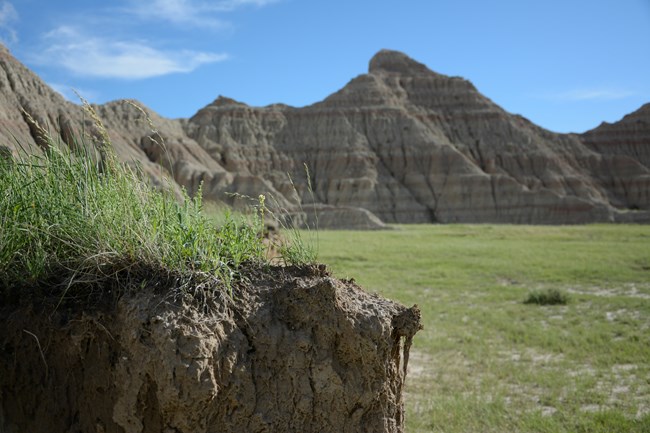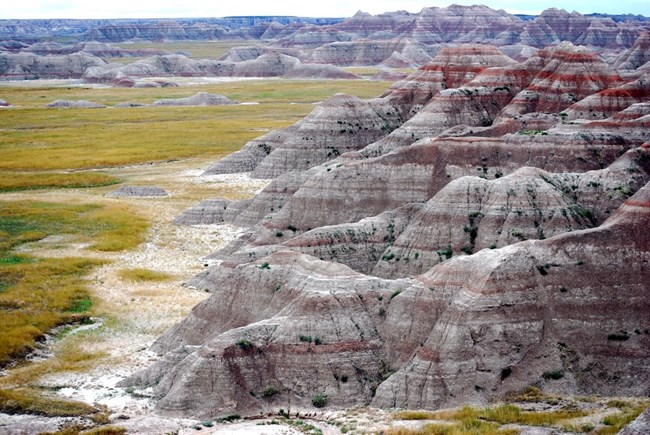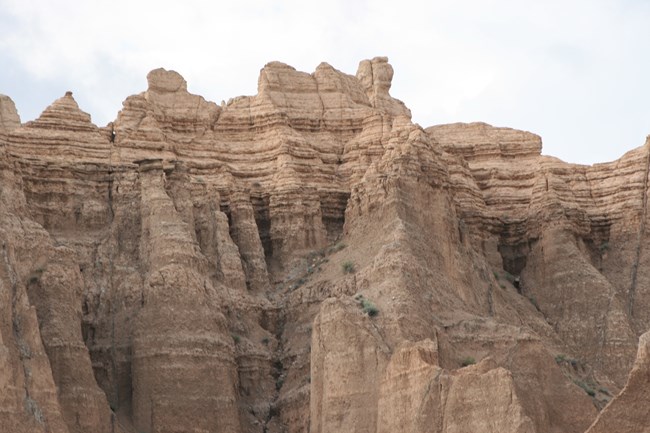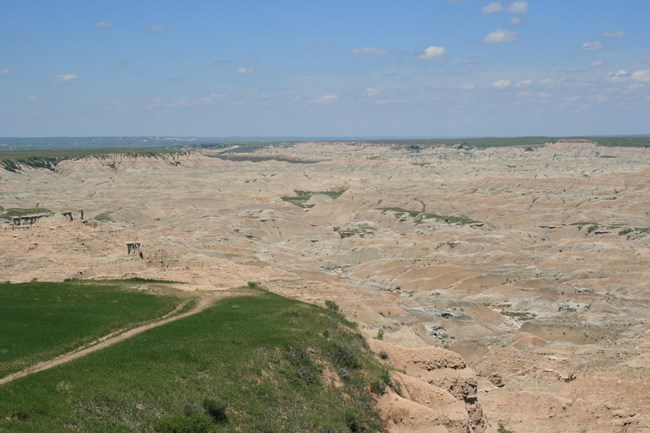Part of a series of articles titled Badlands Geology and Paleontology.
Article
Geologic Formations: How Badlands Buttes Came to Be

NPS Photo

NPS Photo / Troy Hunt
How did the Badlands get there? Why do they look like that?
The formations in Badlands National Park and badlands formations around the world are the end-product of two simple processes: deposition and erosion.
Deposition is the process of rocks gradually building up. Over the course of millions of years, the layered rocks of the Badlands were slowly stacked on top of each other like a layer cake. These rocks were deposited by a number of natural forces which range from shallow inland seas to rivers to wind. Deposition began about 75 million years ago with the formation of the Pierre Shale, the base of the geologic formations in the park. Deposition ended about 28 million years ago with the Sharps Formation, the uppermost unit of Badlands stratigraphy.
Erosion is the process of rocks gradually wearing away. The Badlands began eroding about 500,000 years ago as the Cheyenne and White Rivers carved their way through the landscape. They are the reason for the narrow channels, canyons, and rugged peaks of the Badlands which we see today. And the Badlands are still eroding – it is estimated that the Badlands erode at the rate of one inch per year, which is a rapid rate for rocks. In contrast, the granite of the Black Hills, to the west of Badlands National Park, erodes at the rate of one inch per 10,000 years. Scientists estimate that in the next 500,000 years, the Badlands will have eroded completely – come visit the park while you can!

NPS Photo
Badlands… This term sounds familiar. Have I heard it before?
You may have heard the term “badlands” used before, but not in reference to our park. That’s because in addition to being a geographic term, describing Badlands National Park in South Dakota, this word is also a geologic term! The lowercase version of badlands is used to describe most terrains that look like the formations in our park. They are typically characterized by soft sedimentary rocks that erode easily.
There are badlands formations all over country in places like Wyoming, Utah, North Dakota, Colorado, and Nebraska. You can even check out badlands formations in the National Park Service like Theodore Roosevelt National Park in North Dakota and Petrified Forest National Park in Arizona, or opt for ones on National Grasslands like Toadstool Geologic Park in Nebraska. There are also badlands formations found throughout the world in Canada, New Zealand, Italy, Spain, and Argentina.

NPS Photo
What kind of rocks are those?
There are a number of rock types that can be found in the Badlands. The formations in our park contain sandstones, siltstones, mudstones, claystones, limestones, volcanic ash, and shale. These rock types come from a number of different sources. For example, many of the sandstones found in Badlands are the remnants of ancient river channels. The occasional limestone lenses found in the park come from calcium-rich groundwater flowing through ancient lakes and precipitating out calcium carbonate, otherwise known as limestone.
Volcanic ash found in the Badlands comes from eruptions in the Great Basin, a geologic province including states like Utah and Nevada. Most of this ash was washed into the area along with eroded sediment from the Black Hills, making many of the rock layers an ash-sediment mixture, which often consists of 50% ash and 50% eroded sediment. There is only one layer of pure volcanic ash, called the Rockyford Ash, in the park.

NPS Photo
How about the layers? What’s the deal with those?
The layers of the Badlands correspond with different moments in geologic time. They start with the oldest layer at the bottom, then move upwards in space and time towards the youngest layer, which sits on top of the formations. To unlock the stories of the park’s different layers, it is often easiest to start where most good stories do: at the beginning.
The Pierre Shale, which forms the bottommost layer of the park’s geology, was deposited 75-69 million years ago. It was laid down by a shallow inland sea known as the Western Interior Seaway. This seaway stretched from the Gulf of Mexico to the Arctic Ocean, covering most of the modern Great Plains in shallow, warm water. This sea contained ancient marine life which would have existed at the same time as dinosaurs, but because dinosaurs couldn’t swim, none of them are found in the Pierre Shale or in the Badlands as a whole. Instead, the creatures that we find from this time include shelled cephalopods like ammonites and baculites alongside mosasaur, a giant marine reptile that could measure over 50 feet long.
On top of the Pierre Shale sit the Yellow Mounds, which are just an altered version of the Pierre Shale despite their striking differences in appearance. After the Western Interior Seaway drained North into the Arctic Ocean, the leftover shales weathered into soils. Those soils are now preserved as the Yellow Mounds, which are what geologists call a paleosol. Paleosols are ancient fossilized soils preserved in the rock record, and they often appear as brightly colored layers like the Yellow Mounds, which gets its mustardy color from a mineral called Goethite.
The Chadron Formation, consisting largely of light gray claystone beds, was deposited about 37-34 million years ago across an ancient floodplain. The environment of the Chadron Formation would have been hot and wet, like Everglades National Park is today. It was home to creatures that we associate with these modern environments like ancient alligators, as well as some animals that no longer exist, like the massive Brontothere.
The Brule Formation, deposited 34-30 million years ago, represents a cooler and drier time in geologic history. The hot, wet vegetated floodplains of the Chadron Formation now transformed into an open savannah, where occasional river channels would cut through the plains. Many grazers, like the oreodonts commonly found in Badlands National Park, made good use of eating the grasses and plants which grew here. Consequently, there were also predators who made good use of the grazers, like nimravid, a cat-like animal with saber teeth.
Above the Brule lies the Sharps Formation, the youngest geologic formation of the park at 30-28 million years old. The base of the Sharps Formation is the Rockyford Ash, a volcanic tuff formed from ash that came from eruptions in the Great Basin, where Utah and Nevada are today. Much of the Sharps Formation is characterized by sandstone river channels as the climate continued to cool and dry.
Last updated: November 10, 2020
